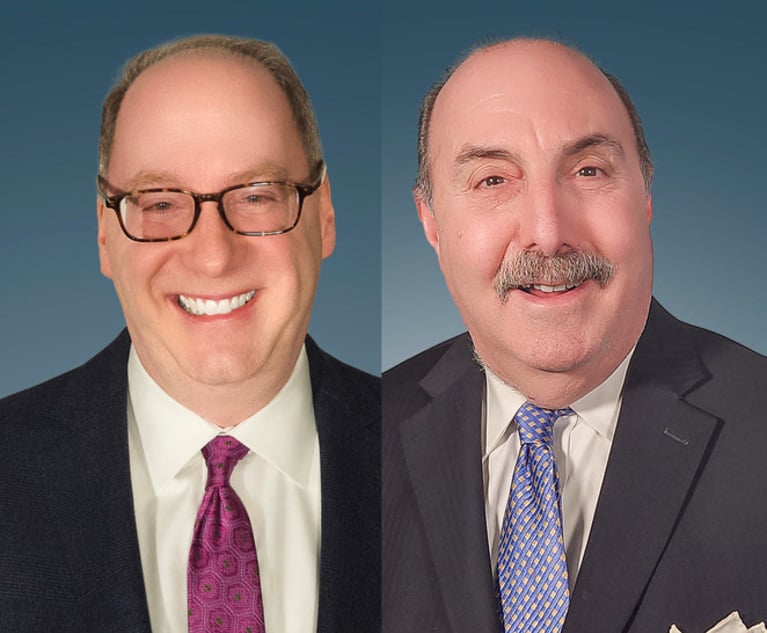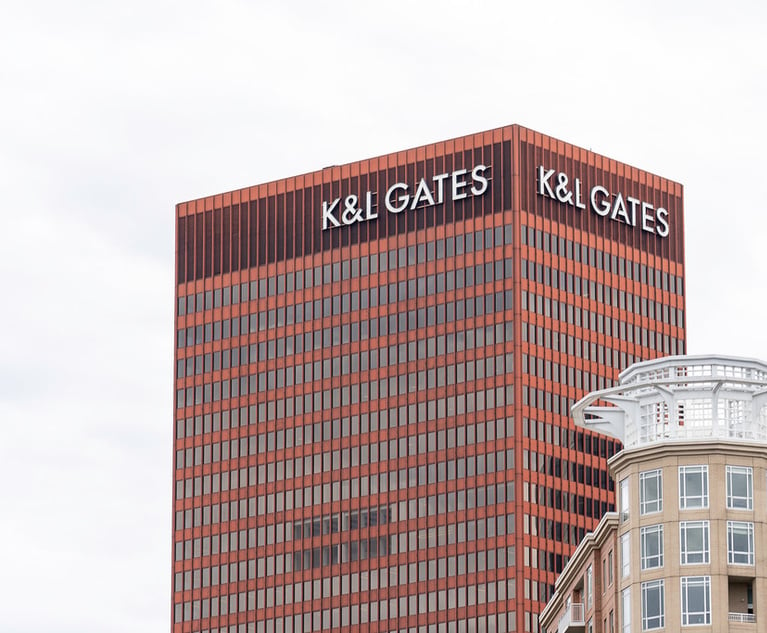Case Tackles Whether Church Building Was Properly Designated as Historic
In Rector Church Wardens v. Philadelphia, the Pennsylvania Commonwealth Court recently addressed whether the Philadelphia Historical Commission properly designated a building owned by a church as historic.
July 23, 2019 at 12:57 PM
8 minute read
 Alan Nochumson.
Alan Nochumson.
When I visited London last month, I recognized how well its buildings have been preserved and adapted to modern life.
However, there is a balance between preserving and even adapting an older building with demolishing and replacing it with one that may be better utilized today and well into the future.
In Rector Church Wardens v. Philadelphia, 2019 Pa. Commw. LEXIS 650 (July 11, 2019), the Pennsylvania Commonwealth Court recently addressed whether the Philadelphia Historical Commission properly designated a building owned by a church as historic, thus, preventing the church from demolishing the building and replace it with a modern one.
In Rector, the Rector Church Wardens and Vestrymen of Trinity Church owned the Parish House, which is located on the same parcel of land as its actual church building in Northeast Philadelphia, the opinion said.
The Parish House was constructed in two phases in 1928 and 1963, the opinion said.
In 1928, the building's construction followed the city's sesquicentennial celebration featuring the Colonial Revival architecture style, the opinion said.
During its second phase of construction, the building was enlarged to resemble that same Colonial Revival style, the opinion said.
During its existence, the building has only been used by the church for secular purposes and served as an income-producing building, the opinion said.
In 2015, the church stopped leasing the Parish House, the opinion said.
In 2017, when it was discovered that the church was contemplating demolishing the Parish House, the Preservation Alliance for Greater Philadelphia nominated the building for historic designation pursuant to Chapter 14-1001 et seq. of the Philadelphia Code, commonly known as the preservation ordinance.
Under Chapter 14-1004(1) of the Philadelphia Code, “a]building, complex of buildings, structure, site, object, or district may be designated for preservation if it: (a) has significant character, interest, or value as part of the development, heritage, or cultural characteristics of the city, commonwealth, or nation or is associated with the life of a person significant in the past; (b) is associated with an event of importance to the history of the city, commonwealth or nation; (c) reflects the environment in an era characterized by a distinctive architectural style; (d) embodies distinguishing characteristics of an architectural style or engineering specimen; (e) is the work of a designer, architect, landscape architect or designer, or professional engineer whose work has significantly influenced the historical, architectural, economic, social, or cultural development of the city, commonwealth, or nation; (f) contains elements of design, detail, materials, or craftsmanship that represent a significant innovation; (g) is part of or related to a square, park, or other distinctive area that should be preserved according to a historic, cultural, or architectural motif; (h) owing to its unique location or singular physical characteristic, represents an established and familiar visual feature of the neighborhood, community, or city; (i) has yielded, or may be likely to yield, information important in pre-history or history; or (j) exemplifies the cultural, political, economic, social, or historical heritage of the community.”
The nomination submitted by the Preservation Alliance proposed that the Parish House specifically met the criteria set forth in subparagraphs (c), (d), and (j) of Chapter 14-1004(1).
The Committee on Historic Designation, which reports to the Philadelphia Historical Commission, met to consider the nomination.
The five-person designation committee consisted of two architectural historians, an archaeologist and a registered architect, the opinion said.
During the meeting of the designation committee, the Preservation Alliance and members of the community presented their views on the architectural and historic importance of the Parish House as well as why the building was such an integral part of its community.
At the meeting, the church stated its opposition to the historic designation, explaining its financial difficulties in maintaining the building any longer, the opinion said.
The church also disclosed at the meeting that it was in negotiations with a third party to demolish the building and either sell or lease that portion of its property to them so they could construct a gas station/convenience store in its place, the opinion said.
After discussing the comments and considered the arguments made by the parties, the designation committee voted to recommend to the historical commission that the Parish House met the criteria for historic designation.
Soon thereafter, the historical commission held a public meeting where it considered the nomination.
At the public meeting, a petition signed by over 3,000 community members supporting the designation was presented to the historical commission, the opinion said.
During the public meeting, the church reiterated its financial difficulties in maintaining the building in its current condition and the necessity of obtaining revenue from the repurposing of the property through the demolition of the building, the opinion said.
The church maintained that a lease or sale of property containing the Parish House was necessary for the church's survival as it was its only secular asset, the opinion said.
Agreeing with the recommendation issued by the designation committee, the historical commission ultimately concluded that the Parish House met the criteria set forth in subparagraphs (c), (d), and (j) of Chapter 14-1004(1) for historic designation.
The church then appealed this administrative ruling to the Philadelphia Court of Common Pleas.
The trial court upheld the historic designation ruled upon by the historical commission, deferring to the historical commission's construction of the preservation ordinance and its application of the designation criteria to the Parish House based upon the evidence so presented.
The church then appealed the trial court's decision to the Commonwealth Court.
On appeal, the Commonwealth Court considered several issues presented by the church.
First and foremost, the church argued that the trial court overlooked an overarching significance criterion in the preservation ordinance.
In particular, the church asserted that the historical commission ignored the “threshold standard for designation: it is not 'significant to the city' as required by Section 14-1003(2)(a) of the preservation ordinance.”
The church reasoned that the Parish House is merely an ordinary example of Colonial Revival style architecture and alluded to the existence of many other examples of that style that would be better, more worthy examples.
Citing to Turchi v. Philadelphia Board of License & Inspection Review, 20 A.3d 590 (Pa. Cmwlth. 2011), the Commonwealth Court emphasized that the preservation ordinance, as set forth in the Philadelphia Code, “empowers the historical commission to render decisions on historic preservation, including designation of buildings for” historic designation.
Furthermore, the Commonwealth Court, quoting Meyer v. City of Pittsburgh Historic Review Commission, 201 A.3d 929 (Pa. Cmwlth. 2019), stated that, “even presuming such an overarching significance requirement exists, … the historical commission has the express authority to determine what qualifies as significant.”
As noted by the Commonwealth Court, “Section 14-1003(2) lists the historical commission's powers and duties 'shall be as follows: designate as historic those buildings, structures, sites and objects the historical commission determines are significant to the city, pursuant to the criteria of Section 14-1004(1).”
In interpreting that section of the Philadelphia Code, the Commonwealth Court concluded that “the historical commission has the discretion to determine what is significant, guided by the criteria in Section 14-1004(1).”
The Commonwealth Court then reviewed whether the historical commission abused its discretion through its historic designation of the Parish House.
According to the church, substantial evidence did not support the historic designation.
In response, the city stated that the record established by the historical commission constituted sufficient evidence in support of the decision handed down by the historical commission.
At the outset, citing to Turchi, the Commonwealth Court indicated that the historical “commission's construction of the preservation ordinance and the designation criteria are entitled to deference” given its “mandated composition of specialists in historical, architectural, and real estate fields.”
Reviewing the record established before the historical commission, the Commonwealth Court upheld the historical commission's designation of the Parish House as a historic place.
In reaching this conclusion, the Commonwealth Court reiterated that, although “only one criterion must be met” for such a historic designation, there is sufficient evidence in the record establishing three of the criteria set forth in Chapter 14-1004(1).
According to the Commonwealth Court, “while most of the evidence relates to criterion … and the role the Parish House played in the history and culture of the community,” it found that the record also contained sufficient evidence establishing that the Parish House reflects specific architectural elements of the Colonial Revival style which the historical commission deemed sufficient for designation under criteria (c) and (d).
The Commonwealth Court emphasized that, while “there are other examples of the Colonial Revival style of architecture does not diminish the necessity for preserving Parish House,” and “an ordinary or representative building constructed in the Colonial Revival style still reflects the era and a distinctive type of architecture.”
Alan Nochumson is the sole shareholder of Nochumson P.C., where his law firm's primary practice areas consist of real estate, litigation, land use and zoning, business formation and general counseling and appellate advocacy. He is also president of Bear Abstract Services, where his title insurance company offers comprehensive title insurance, title examination and closing services. He can be reached at 215-399-1346 or [email protected].
This content has been archived. It is available through our partners, LexisNexis® and Bloomberg Law.
To view this content, please continue to their sites.
Not a Lexis Subscriber?
Subscribe Now
Not a Bloomberg Law Subscriber?
Subscribe Now
NOT FOR REPRINT
© 2025 ALM Global, LLC, All Rights Reserved. Request academic re-use from www.copyright.com. All other uses, submit a request to [email protected]. For more information visit Asset & Logo Licensing.
You Might Like
View All

Products Liability: The Absence of Other Similar Claims—a Defense or a Misleading Effort to Sway a Jury?


K&L Gates Sheds Space, but Will Stay in Flagship Pittsburgh Office After Lease Renewal
Trending Stories
- 1'It's Not Going to Be Pretty': PayPal, Capital One Face Novel Class Actions Over 'Poaching' Commissions Owed Influencers
- 211th Circuit Rejects Trump's Emergency Request as DOJ Prepares to Release Special Counsel's Final Report
- 3Supreme Court Takes Up Challenge to ACA Task Force
- 4'Tragedy of Unspeakable Proportions:' Could Edison, DWP, Face Lawsuits Over LA Wildfires?
- 5Meta Pulls Plug on DEI Programs
Who Got The Work
Michael G. Bongiorno, Andrew Scott Dulberg and Elizabeth E. Driscoll from Wilmer Cutler Pickering Hale and Dorr have stepped in to represent Symbotic Inc., an A.I.-enabled technology platform that focuses on increasing supply chain efficiency, and other defendants in a pending shareholder derivative lawsuit. The case, filed Oct. 2 in Massachusetts District Court by the Brown Law Firm on behalf of Stephen Austen, accuses certain officers and directors of misleading investors in regard to Symbotic's potential for margin growth by failing to disclose that the company was not equipped to timely deploy its systems or manage expenses through project delays. The case, assigned to U.S. District Judge Nathaniel M. Gorton, is 1:24-cv-12522, Austen v. Cohen et al.
Who Got The Work
Edmund Polubinski and Marie Killmond of Davis Polk & Wardwell have entered appearances for data platform software development company MongoDB and other defendants in a pending shareholder derivative lawsuit. The action, filed Oct. 7 in New York Southern District Court by the Brown Law Firm, accuses the company's directors and/or officers of falsely expressing confidence in the company’s restructuring of its sales incentive plan and downplaying the severity of decreases in its upfront commitments. The case is 1:24-cv-07594, Roy v. Ittycheria et al.
Who Got The Work
Amy O. Bruchs and Kurt F. Ellison of Michael Best & Friedrich have entered appearances for Epic Systems Corp. in a pending employment discrimination lawsuit. The suit was filed Sept. 7 in Wisconsin Western District Court by Levine Eisberner LLC and Siri & Glimstad on behalf of a project manager who claims that he was wrongfully terminated after applying for a religious exemption to the defendant's COVID-19 vaccine mandate. The case, assigned to U.S. Magistrate Judge Anita Marie Boor, is 3:24-cv-00630, Secker, Nathan v. Epic Systems Corporation.
Who Got The Work
David X. Sullivan, Thomas J. Finn and Gregory A. Hall from McCarter & English have entered appearances for Sunrun Installation Services in a pending civil rights lawsuit. The complaint was filed Sept. 4 in Connecticut District Court by attorney Robert M. Berke on behalf of former employee George Edward Steins, who was arrested and charged with employing an unregistered home improvement salesperson. The complaint alleges that had Sunrun informed the Connecticut Department of Consumer Protection that the plaintiff's employment had ended in 2017 and that he no longer held Sunrun's home improvement contractor license, he would not have been hit with charges, which were dismissed in May 2024. The case, assigned to U.S. District Judge Jeffrey A. Meyer, is 3:24-cv-01423, Steins v. Sunrun, Inc. et al.
Who Got The Work
Greenberg Traurig shareholder Joshua L. Raskin has entered an appearance for boohoo.com UK Ltd. in a pending patent infringement lawsuit. The suit, filed Sept. 3 in Texas Eastern District Court by Rozier Hardt McDonough on behalf of Alto Dynamics, asserts five patents related to an online shopping platform. The case, assigned to U.S. District Judge Rodney Gilstrap, is 2:24-cv-00719, Alto Dynamics, LLC v. boohoo.com UK Limited.
Featured Firms
Law Offices of Gary Martin Hays & Associates, P.C.
(470) 294-1674
Law Offices of Mark E. Salomone
(857) 444-6468
Smith & Hassler
(713) 739-1250





